Comprehensive Report on IAS 36 Impairment of Assets and Valuation
VerifiedAdded on 2020/07/22
|8
|1874
|80
Report
AI Summary
This report provides a detailed analysis of IAS 36, focusing on the impairment of assets. It begins with an introduction to the objectives of IAS 36, emphasizing the importance of asset valuation and depreciation in maintaining a firm's financial health. The report then explores the relevance of fair value and disposal value in asset valuation, followed by a discussion on internal and external indications of asset impairment. It outlines the determination of the recoverable amount of assets and includes practical asset valuation calculations, such as the determination of value in use, impairment loss, and depreciation using the straight-line method. The report concludes by summarizing the key findings and emphasizing the significance of accurate asset valuation and adherence to IAS 36 for sound financial reporting. Various references are provided to support the analysis, including journal articles and online resources.

FINANCE
Paraphrase This Document
Need a fresh take? Get an instant paraphrase of this document with our AI Paraphraser

TABLE OF CONTENTS
INTRODUCTION...........................................................................................................................1
1. Evaluating the objectives of IAS36 impairment of assets......................................................1
2. Relevance of assets fair value and disposal value...................................................................2
3. Main indications which in turn suggesting the impairment of assets.....................................2
4. Determination of recoverable amount of assets......................................................................3
5. Asset valuation........................................................................................................................3
CONCLUSIONS..............................................................................................................................5
REFERENCES................................................................................................................................6
INTRODUCTION...........................................................................................................................1
1. Evaluating the objectives of IAS36 impairment of assets......................................................1
2. Relevance of assets fair value and disposal value...................................................................2
3. Main indications which in turn suggesting the impairment of assets.....................................2
4. Determination of recoverable amount of assets......................................................................3
5. Asset valuation........................................................................................................................3
CONCLUSIONS..............................................................................................................................5
REFERENCES................................................................................................................................6
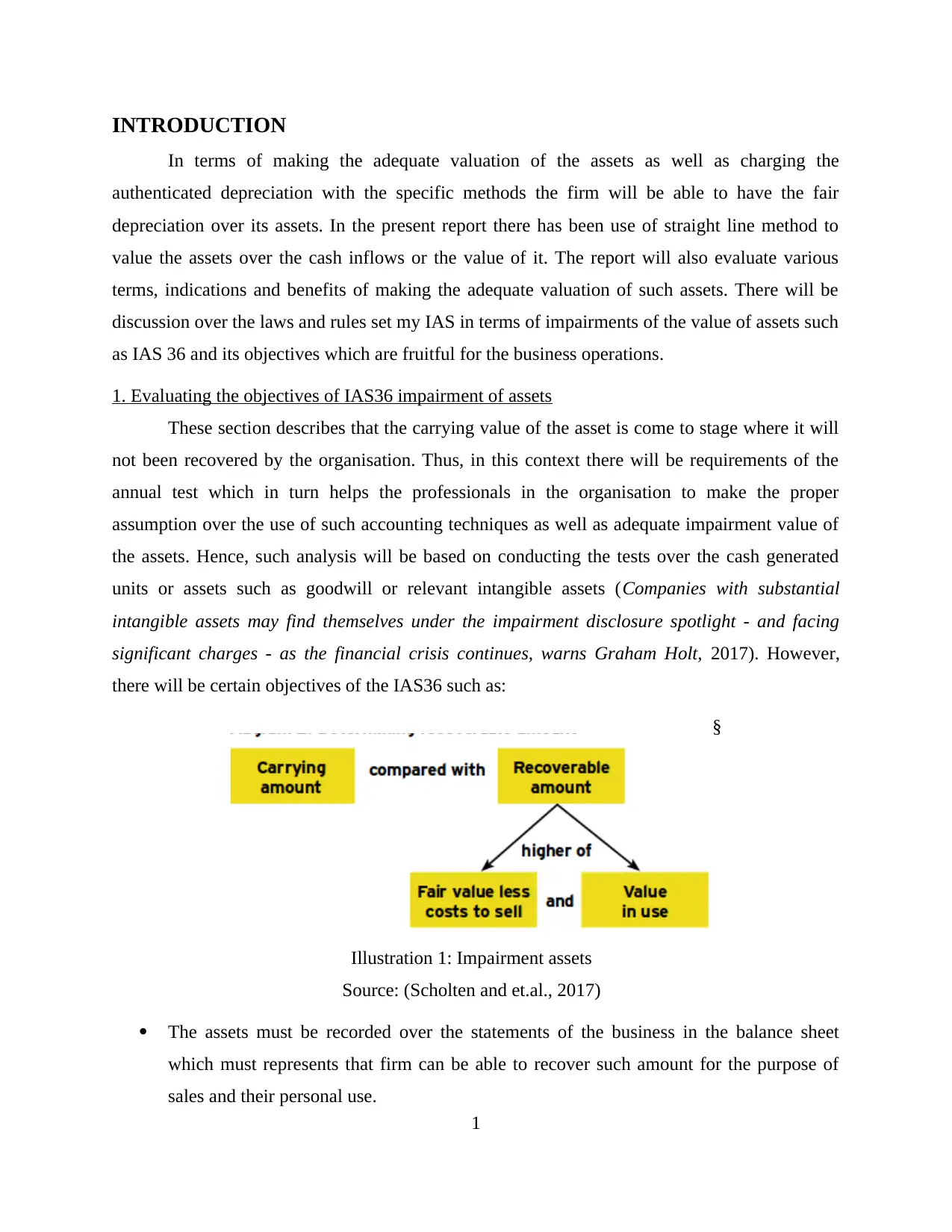
INTRODUCTION
In terms of making the adequate valuation of the assets as well as charging the
authenticated depreciation with the specific methods the firm will be able to have the fair
depreciation over its assets. In the present report there has been use of straight line method to
value the assets over the cash inflows or the value of it. The report will also evaluate various
terms, indications and benefits of making the adequate valuation of such assets. There will be
discussion over the laws and rules set my IAS in terms of impairments of the value of assets such
as IAS 36 and its objectives which are fruitful for the business operations.
1. Evaluating the objectives of IAS36 impairment of assets
These section describes that the carrying value of the asset is come to stage where it will
not been recovered by the organisation. Thus, in this context there will be requirements of the
annual test which in turn helps the professionals in the organisation to make the proper
assumption over the use of such accounting techniques as well as adequate impairment value of
the assets. Hence, such analysis will be based on conducting the tests over the cash generated
units or assets such as goodwill or relevant intangible assets (Companies with substantial
intangible assets may find themselves under the impairment disclosure spotlight - and facing
significant charges - as the financial crisis continues, warns Graham Holt, 2017). However,
there will be certain objectives of the IAS36 such as:
Illustration 1: Impairment assets
Source: (Scholten and et.al., 2017)
§
The assets must be recorded over the statements of the business in the balance sheet
which must represents that firm can be able to recover such amount for the purpose of
sales and their personal use.
1
In terms of making the adequate valuation of the assets as well as charging the
authenticated depreciation with the specific methods the firm will be able to have the fair
depreciation over its assets. In the present report there has been use of straight line method to
value the assets over the cash inflows or the value of it. The report will also evaluate various
terms, indications and benefits of making the adequate valuation of such assets. There will be
discussion over the laws and rules set my IAS in terms of impairments of the value of assets such
as IAS 36 and its objectives which are fruitful for the business operations.
1. Evaluating the objectives of IAS36 impairment of assets
These section describes that the carrying value of the asset is come to stage where it will
not been recovered by the organisation. Thus, in this context there will be requirements of the
annual test which in turn helps the professionals in the organisation to make the proper
assumption over the use of such accounting techniques as well as adequate impairment value of
the assets. Hence, such analysis will be based on conducting the tests over the cash generated
units or assets such as goodwill or relevant intangible assets (Companies with substantial
intangible assets may find themselves under the impairment disclosure spotlight - and facing
significant charges - as the financial crisis continues, warns Graham Holt, 2017). However,
there will be certain objectives of the IAS36 such as:
Illustration 1: Impairment assets
Source: (Scholten and et.al., 2017)
§
The assets must be recorded over the statements of the business in the balance sheet
which must represents that firm can be able to recover such amount for the purpose of
sales and their personal use.
1
⊘ This is a preview!⊘
Do you want full access?
Subscribe today to unlock all pages.

Trusted by 1+ million students worldwide
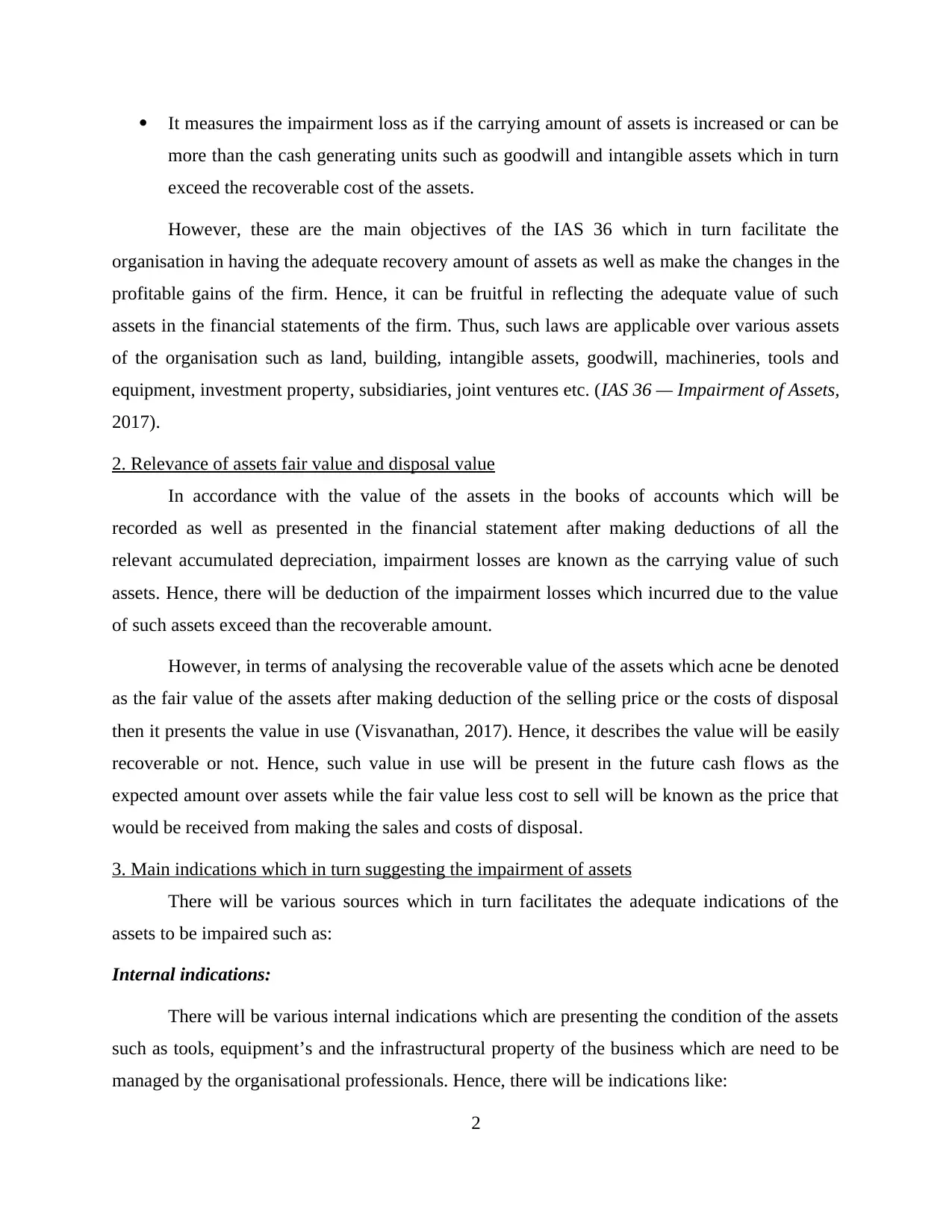
It measures the impairment loss as if the carrying amount of assets is increased or can be
more than the cash generating units such as goodwill and intangible assets which in turn
exceed the recoverable cost of the assets.
However, these are the main objectives of the IAS 36 which in turn facilitate the
organisation in having the adequate recovery amount of assets as well as make the changes in the
profitable gains of the firm. Hence, it can be fruitful in reflecting the adequate value of such
assets in the financial statements of the firm. Thus, such laws are applicable over various assets
of the organisation such as land, building, intangible assets, goodwill, machineries, tools and
equipment, investment property, subsidiaries, joint ventures etc. (IAS 36 — Impairment of Assets,
2017).
2. Relevance of assets fair value and disposal value
In accordance with the value of the assets in the books of accounts which will be
recorded as well as presented in the financial statement after making deductions of all the
relevant accumulated depreciation, impairment losses are known as the carrying value of such
assets. Hence, there will be deduction of the impairment losses which incurred due to the value
of such assets exceed than the recoverable amount.
However, in terms of analysing the recoverable value of the assets which acne be denoted
as the fair value of the assets after making deduction of the selling price or the costs of disposal
then it presents the value in use (Visvanathan, 2017). Hence, it describes the value will be easily
recoverable or not. Hence, such value in use will be present in the future cash flows as the
expected amount over assets while the fair value less cost to sell will be known as the price that
would be received from making the sales and costs of disposal.
3. Main indications which in turn suggesting the impairment of assets
There will be various sources which in turn facilitates the adequate indications of the
assets to be impaired such as:
Internal indications:
There will be various internal indications which are presenting the condition of the assets
such as tools, equipment’s and the infrastructural property of the business which are need to be
managed by the organisational professionals. Hence, there will be indications like:
2
more than the cash generating units such as goodwill and intangible assets which in turn
exceed the recoverable cost of the assets.
However, these are the main objectives of the IAS 36 which in turn facilitate the
organisation in having the adequate recovery amount of assets as well as make the changes in the
profitable gains of the firm. Hence, it can be fruitful in reflecting the adequate value of such
assets in the financial statements of the firm. Thus, such laws are applicable over various assets
of the organisation such as land, building, intangible assets, goodwill, machineries, tools and
equipment, investment property, subsidiaries, joint ventures etc. (IAS 36 — Impairment of Assets,
2017).
2. Relevance of assets fair value and disposal value
In accordance with the value of the assets in the books of accounts which will be
recorded as well as presented in the financial statement after making deductions of all the
relevant accumulated depreciation, impairment losses are known as the carrying value of such
assets. Hence, there will be deduction of the impairment losses which incurred due to the value
of such assets exceed than the recoverable amount.
However, in terms of analysing the recoverable value of the assets which acne be denoted
as the fair value of the assets after making deduction of the selling price or the costs of disposal
then it presents the value in use (Visvanathan, 2017). Hence, it describes the value will be easily
recoverable or not. Hence, such value in use will be present in the future cash flows as the
expected amount over assets while the fair value less cost to sell will be known as the price that
would be received from making the sales and costs of disposal.
3. Main indications which in turn suggesting the impairment of assets
There will be various sources which in turn facilitates the adequate indications of the
assets to be impaired such as:
Internal indications:
There will be various internal indications which are presenting the condition of the assets
such as tools, equipment’s and the infrastructural property of the business which are need to be
managed by the organisational professionals. Hence, there will be indications like:
2
Paraphrase This Document
Need a fresh take? Get an instant paraphrase of this document with our AI Paraphraser
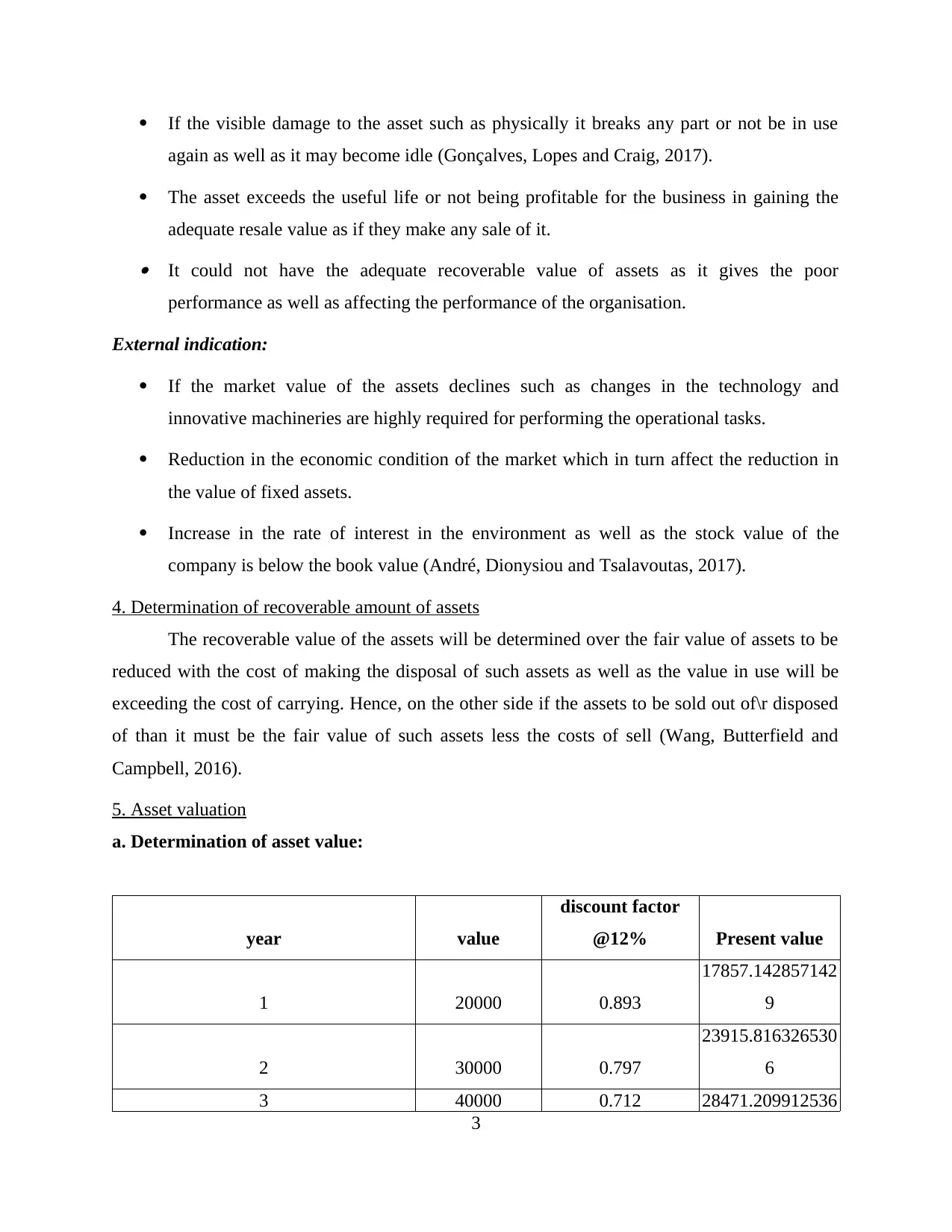
If the visible damage to the asset such as physically it breaks any part or not be in use
again as well as it may become idle (Gonçalves, Lopes and Craig, 2017).
The asset exceeds the useful life or not being profitable for the business in gaining the
adequate resale value as if they make any sale of it. It could not have the adequate recoverable value of assets as it gives the poor
performance as well as affecting the performance of the organisation.
External indication:
If the market value of the assets declines such as changes in the technology and
innovative machineries are highly required for performing the operational tasks.
Reduction in the economic condition of the market which in turn affect the reduction in
the value of fixed assets.
Increase in the rate of interest in the environment as well as the stock value of the
company is below the book value (André, Dionysiou and Tsalavoutas, 2017).
4. Determination of recoverable amount of assets
The recoverable value of the assets will be determined over the fair value of assets to be
reduced with the cost of making the disposal of such assets as well as the value in use will be
exceeding the cost of carrying. Hence, on the other side if the assets to be sold out of\r disposed
of than it must be the fair value of such assets less the costs of sell (Wang, Butterfield and
Campbell, 2016).
5. Asset valuation
a. Determination of asset value:
year value
discount factor
@12% Present value
1 20000 0.893
17857.142857142
9
2 30000 0.797
23915.816326530
6
3 40000 0.712 28471.209912536
3
again as well as it may become idle (Gonçalves, Lopes and Craig, 2017).
The asset exceeds the useful life or not being profitable for the business in gaining the
adequate resale value as if they make any sale of it. It could not have the adequate recoverable value of assets as it gives the poor
performance as well as affecting the performance of the organisation.
External indication:
If the market value of the assets declines such as changes in the technology and
innovative machineries are highly required for performing the operational tasks.
Reduction in the economic condition of the market which in turn affect the reduction in
the value of fixed assets.
Increase in the rate of interest in the environment as well as the stock value of the
company is below the book value (André, Dionysiou and Tsalavoutas, 2017).
4. Determination of recoverable amount of assets
The recoverable value of the assets will be determined over the fair value of assets to be
reduced with the cost of making the disposal of such assets as well as the value in use will be
exceeding the cost of carrying. Hence, on the other side if the assets to be sold out of\r disposed
of than it must be the fair value of such assets less the costs of sell (Wang, Butterfield and
Campbell, 2016).
5. Asset valuation
a. Determination of asset value:
year value
discount factor
@12% Present value
1 20000 0.893
17857.142857142
9
2 30000 0.797
23915.816326530
6
3 40000 0.712 28471.209912536
3
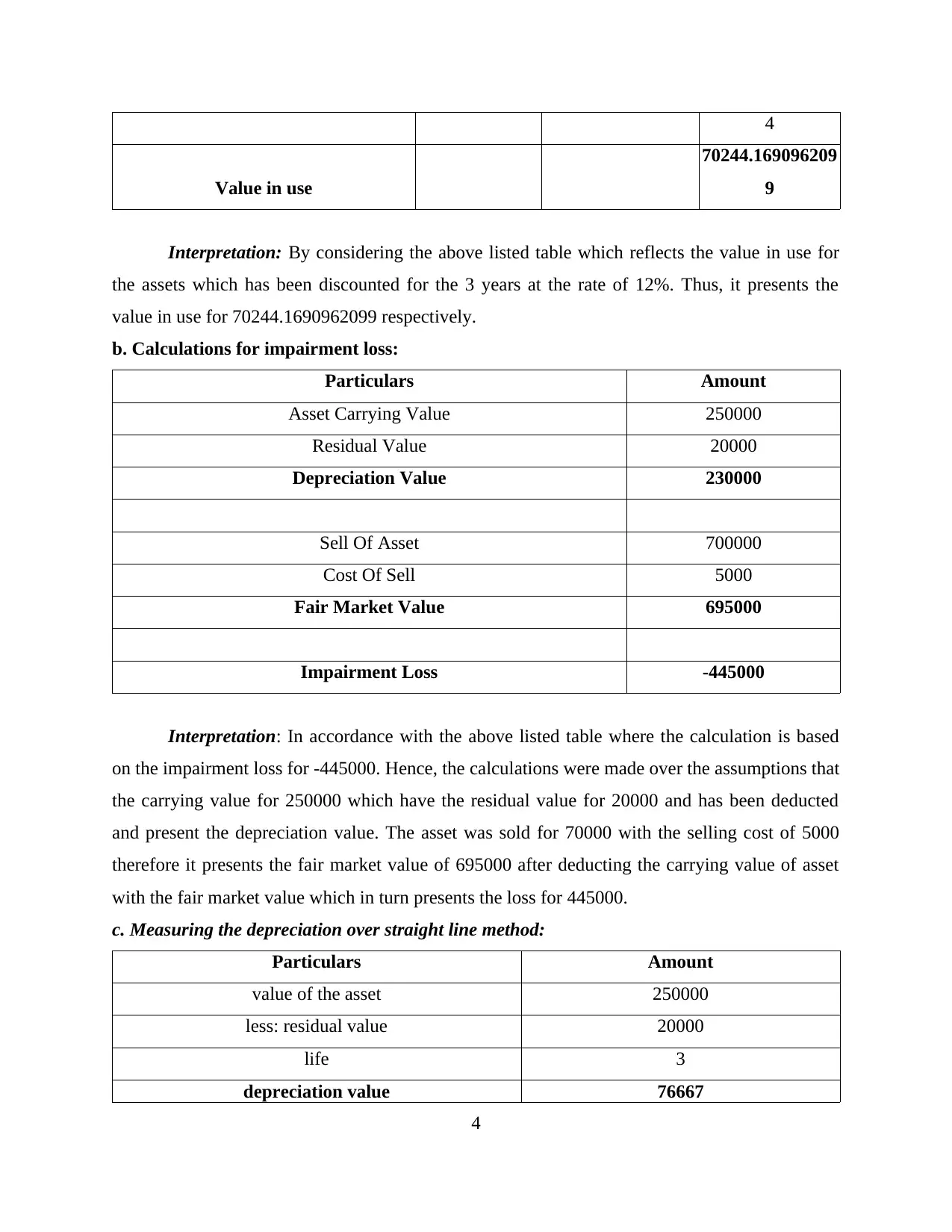
4
Value in use
70244.169096209
9
Interpretation: By considering the above listed table which reflects the value in use for
the assets which has been discounted for the 3 years at the rate of 12%. Thus, it presents the
value in use for 70244.1690962099 respectively.
b. Calculations for impairment loss:
Particulars Amount
Asset Carrying Value 250000
Residual Value 20000
Depreciation Value 230000
Sell Of Asset 700000
Cost Of Sell 5000
Fair Market Value 695000
Impairment Loss -445000
Interpretation: In accordance with the above listed table where the calculation is based
on the impairment loss for -445000. Hence, the calculations were made over the assumptions that
the carrying value for 250000 which have the residual value for 20000 and has been deducted
and present the depreciation value. The asset was sold for 70000 with the selling cost of 5000
therefore it presents the fair market value of 695000 after deducting the carrying value of asset
with the fair market value which in turn presents the loss for 445000.
c. Measuring the depreciation over straight line method:
Particulars Amount
value of the asset 250000
less: residual value 20000
life 3
depreciation value 76667
4
Value in use
70244.169096209
9
Interpretation: By considering the above listed table which reflects the value in use for
the assets which has been discounted for the 3 years at the rate of 12%. Thus, it presents the
value in use for 70244.1690962099 respectively.
b. Calculations for impairment loss:
Particulars Amount
Asset Carrying Value 250000
Residual Value 20000
Depreciation Value 230000
Sell Of Asset 700000
Cost Of Sell 5000
Fair Market Value 695000
Impairment Loss -445000
Interpretation: In accordance with the above listed table where the calculation is based
on the impairment loss for -445000. Hence, the calculations were made over the assumptions that
the carrying value for 250000 which have the residual value for 20000 and has been deducted
and present the depreciation value. The asset was sold for 70000 with the selling cost of 5000
therefore it presents the fair market value of 695000 after deducting the carrying value of asset
with the fair market value which in turn presents the loss for 445000.
c. Measuring the depreciation over straight line method:
Particulars Amount
value of the asset 250000
less: residual value 20000
life 3
depreciation value 76667
4
⊘ This is a preview!⊘
Do you want full access?
Subscribe today to unlock all pages.

Trusted by 1+ million students worldwide

year Depreciable value depreciation value
amount after
Depreciation
1 250000 76667 173333
2 173333 76667 96667
3 96667 76667 20000
Interpretation: In terms of such calculations which are listed above explains that there
will be value of assets is 250000 and the residual value for 20000 and thus it has the useful life of
the assets is 3 years which presents the depreciation value of 76667 over the straight-line
method. Hence, the value of asset after depreciation for the first years is 173333, 2nd year for
96667 and for the 3rd year it is 20000.
CONCLUSIONS
On the basis of this study it will be concluded that in terms making strong financial
position of the business there is need to have the fruitful gains as well as valuation of the assets
in the right manner. Hence, there were calculation based on the depreciating the assets over its
fair value on the straight line method. Thus, various assumptions were made in support with
having the adequate amount of such assets. Further, IAS 36 of the impairment of the asset value
presents the various objectives and the assets it usually operates to make the fruitful changes in
the operational activities as well as the values of them in the books or financial statements.
5
amount after
Depreciation
1 250000 76667 173333
2 173333 76667 96667
3 96667 76667 20000
Interpretation: In terms of such calculations which are listed above explains that there
will be value of assets is 250000 and the residual value for 20000 and thus it has the useful life of
the assets is 3 years which presents the depreciation value of 76667 over the straight-line
method. Hence, the value of asset after depreciation for the first years is 173333, 2nd year for
96667 and for the 3rd year it is 20000.
CONCLUSIONS
On the basis of this study it will be concluded that in terms making strong financial
position of the business there is need to have the fruitful gains as well as valuation of the assets
in the right manner. Hence, there were calculation based on the depreciating the assets over its
fair value on the straight line method. Thus, various assumptions were made in support with
having the adequate amount of such assets. Further, IAS 36 of the impairment of the asset value
presents the various objectives and the assets it usually operates to make the fruitful changes in
the operational activities as well as the values of them in the books or financial statements.
5
Paraphrase This Document
Need a fresh take? Get an instant paraphrase of this document with our AI Paraphraser
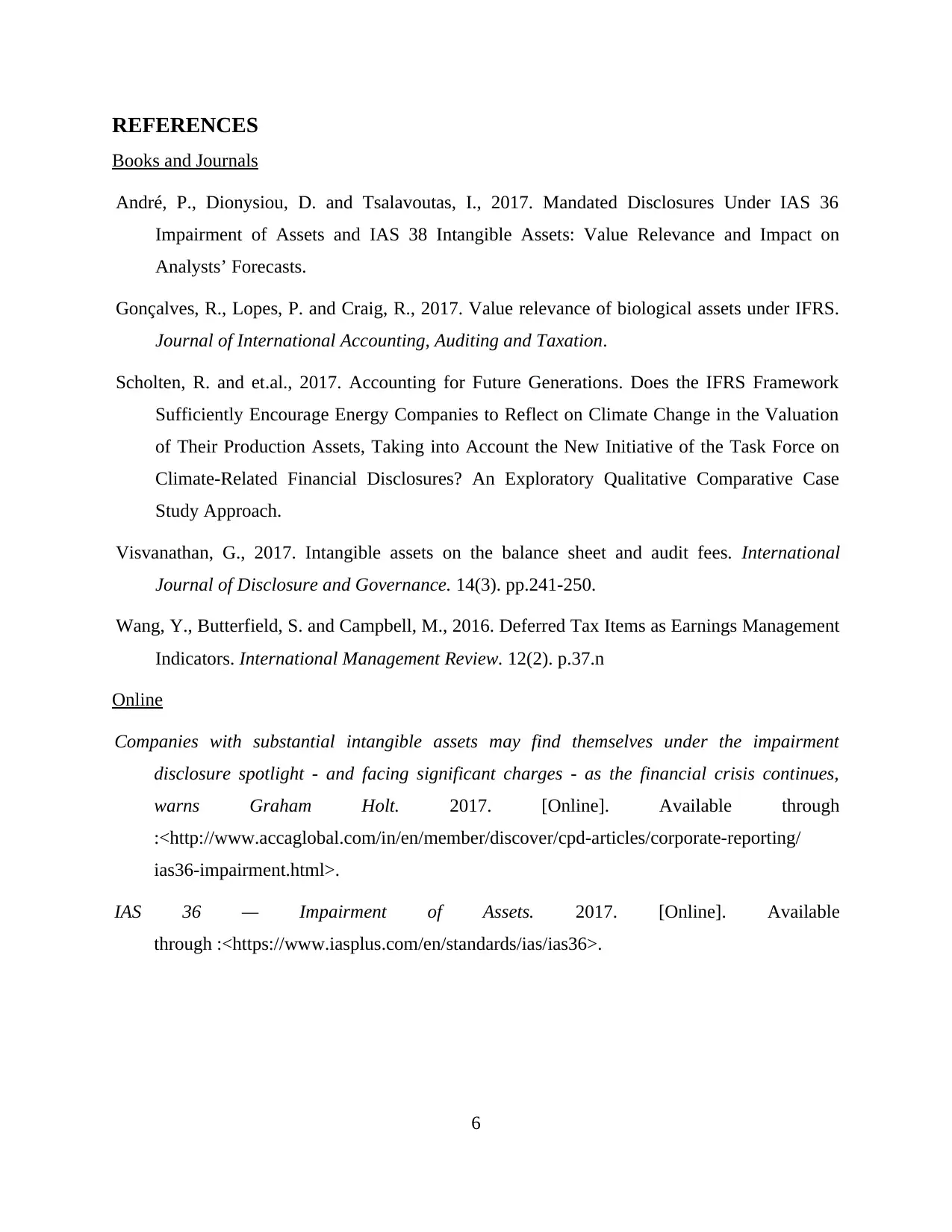
REFERENCES
Books and Journals
André, P., Dionysiou, D. and Tsalavoutas, I., 2017. Mandated Disclosures Under IAS 36
Impairment of Assets and IAS 38 Intangible Assets: Value Relevance and Impact on
Analysts’ Forecasts.
Gonçalves, R., Lopes, P. and Craig, R., 2017. Value relevance of biological assets under IFRS.
Journal of International Accounting, Auditing and Taxation.
Scholten, R. and et.al., 2017. Accounting for Future Generations. Does the IFRS Framework
Sufficiently Encourage Energy Companies to Reflect on Climate Change in the Valuation
of Their Production Assets, Taking into Account the New Initiative of the Task Force on
Climate-Related Financial Disclosures? An Exploratory Qualitative Comparative Case
Study Approach.
Visvanathan, G., 2017. Intangible assets on the balance sheet and audit fees. International
Journal of Disclosure and Governance. 14(3). pp.241-250.
Wang, Y., Butterfield, S. and Campbell, M., 2016. Deferred Tax Items as Earnings Management
Indicators. International Management Review. 12(2). p.37.n
Online
Companies with substantial intangible assets may find themselves under the impairment
disclosure spotlight - and facing significant charges - as the financial crisis continues,
warns Graham Holt. 2017. [Online]. Available through
:<http://www.accaglobal.com/in/en/member/discover/cpd-articles/corporate-reporting/
ias36-impairment.html>.
IAS 36 — Impairment of Assets. 2017. [Online]. Available
through :<https://www.iasplus.com/en/standards/ias/ias36>.
6
Books and Journals
André, P., Dionysiou, D. and Tsalavoutas, I., 2017. Mandated Disclosures Under IAS 36
Impairment of Assets and IAS 38 Intangible Assets: Value Relevance and Impact on
Analysts’ Forecasts.
Gonçalves, R., Lopes, P. and Craig, R., 2017. Value relevance of biological assets under IFRS.
Journal of International Accounting, Auditing and Taxation.
Scholten, R. and et.al., 2017. Accounting for Future Generations. Does the IFRS Framework
Sufficiently Encourage Energy Companies to Reflect on Climate Change in the Valuation
of Their Production Assets, Taking into Account the New Initiative of the Task Force on
Climate-Related Financial Disclosures? An Exploratory Qualitative Comparative Case
Study Approach.
Visvanathan, G., 2017. Intangible assets on the balance sheet and audit fees. International
Journal of Disclosure and Governance. 14(3). pp.241-250.
Wang, Y., Butterfield, S. and Campbell, M., 2016. Deferred Tax Items as Earnings Management
Indicators. International Management Review. 12(2). p.37.n
Online
Companies with substantial intangible assets may find themselves under the impairment
disclosure spotlight - and facing significant charges - as the financial crisis continues,
warns Graham Holt. 2017. [Online]. Available through
:<http://www.accaglobal.com/in/en/member/discover/cpd-articles/corporate-reporting/
ias36-impairment.html>.
IAS 36 — Impairment of Assets. 2017. [Online]. Available
through :<https://www.iasplus.com/en/standards/ias/ias36>.
6
1 out of 8
Related Documents
Your All-in-One AI-Powered Toolkit for Academic Success.
+13062052269
info@desklib.com
Available 24*7 on WhatsApp / Email
![[object Object]](/_next/static/media/star-bottom.7253800d.svg)
Unlock your academic potential
Copyright © 2020–2025 A2Z Services. All Rights Reserved. Developed and managed by ZUCOL.





